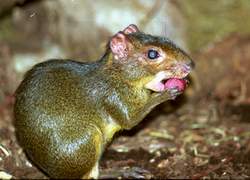Larger nuts end up further from tree

The acouchy is the most important disperser of nuts in the rainforest of French Guyana
Trees are better off if they produce large nuts. This is revealed in research by Patrick Jansen from Wageningen University. Scatterhoarding rodents appear to prefer burying larger nuts for later. The bigger the nut, the further it is buried from the tree and the more frequently it is forgotten.
Biologist Patrick Jansen investigated what happened to nuts as soon as they fell on the ground of the rainforest in French Guyana. He placed thousands of nuts on the ground in the forest. Each nut was marked with a numbered fluorescent thread. Using video cameras he observed which animals removed the nuts. He then traced the nuts using the threads sticking out of the ground and followed them until they were either eaten or grew into a seedling.
He found that the vast majority of nuts were taken by acouchies, large guinea-pig-like rodents, which are active during the day. These animals mostly use the nuts for their food store. Each nut is buried separately at a different location in the forest soil.
The rodents were found to be fussy. Larger nuts have a far greater chance of being successfully dispersed than smaller ones, as they are buried more frequently and further away. Sometimes they are buried as far as 100 metres away from the tree. The rodents often forget such nuts and therefore these can successfully germinate.
The scientist concluded, partly on the basis of other aspects of his research, that nut-producing trees may have evolved due to the fussiness of the hoarding animals. Trees which produce large nuts obtain many offspring. Over the course of time the number of trees producing large nuts increases and the number producing small nuts decreases.
According to the biologist, protecting animals in managed forests is important for tree regeneration. That has hardly happened up until now. For example, once logging has taken place the tracks for this are used by hunters who are after rodents and other important seed dispersers.
Media Contact
More Information:
http://www.nwo.nlAll latest news from the category: Life Sciences and Chemistry
Articles and reports from the Life Sciences and chemistry area deal with applied and basic research into modern biology, chemistry and human medicine.
Valuable information can be found on a range of life sciences fields including bacteriology, biochemistry, bionics, bioinformatics, biophysics, biotechnology, genetics, geobotany, human biology, marine biology, microbiology, molecular biology, cellular biology, zoology, bioinorganic chemistry, microchemistry and environmental chemistry.
Newest articles

Superradiant atoms could push the boundaries of how precisely time can be measured
Superradiant atoms can help us measure time more precisely than ever. In a new study, researchers from the University of Copenhagen present a new method for measuring the time interval,…

Ion thermoelectric conversion devices for near room temperature
The electrode sheet of the thermoelectric device consists of ionic hydrogel, which is sandwiched between the electrodes to form, and the Prussian blue on the electrode undergoes a redox reaction…

Zap Energy achieves 37-million-degree temperatures in a compact device
New publication reports record electron temperatures for a small-scale, sheared-flow-stabilized Z-pinch fusion device. In the nine decades since humans first produced fusion reactions, only a few fusion technologies have demonstrated…





















